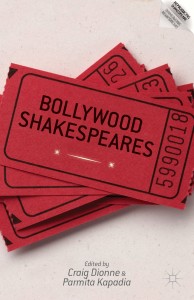India produces more films per year than any other nation, yet only a smattering of these relate to Shakespeare. Dr Deana Rankin, Senior Lecturer at Royal Holloway, University of London, looks at recent attempts to explore why that might be.
 About the author: Dr Deana Rankin is Senior Lecturer in English and Drama at Royal Holloway, University of London. Before that she was the Muriel Bradbrook Fellow and Director of Studies at Girton College, Cambridge. She is the author of Between Spenser and Swift: English Writing in Seventeenth-Century Ireland (CUP, 2009). She is Senior Project leader/mentor with Dr Preti Taneji and Koel Chatterjee on the Shakespeare and Bollywood 2014-16 project.
E-mail: Deana.Rankin@rhul.ac.uk
About the author: Dr Deana Rankin is Senior Lecturer in English and Drama at Royal Holloway, University of London. Before that she was the Muriel Bradbrook Fellow and Director of Studies at Girton College, Cambridge. She is the author of Between Spenser and Swift: English Writing in Seventeenth-Century Ireland (CUP, 2009). She is Senior Project leader/mentor with Dr Preti Taneji and Koel Chatterjee on the Shakespeare and Bollywood 2014-16 project.
E-mail: Deana.Rankin@rhul.ac.uk
 Last year saw the official celebration of the first 100 years of Indian cinema; this year, I am supervising dissertations on Shakespeare and Hindi cinema for the first time at all three levels: BA, MA and PhD; in late June, delegates walking up Tottenham Court Road to attend the first ever UK conference on Shakespeare and Bollywood, passed a ticket booth with special offers on a long list of ’Bollywood Influence’ West End shows. Bollywood Shakespeares is, then, a very timely essay collection and the editors, Craig Dionne and Parmita Kapadia, are extremely well-placed to comment on this new Shakespearean wave.
Last year saw the official celebration of the first 100 years of Indian cinema; this year, I am supervising dissertations on Shakespeare and Hindi cinema for the first time at all three levels: BA, MA and PhD; in late June, delegates walking up Tottenham Court Road to attend the first ever UK conference on Shakespeare and Bollywood, passed a ticket booth with special offers on a long list of ’Bollywood Influence’ West End shows. Bollywood Shakespeares is, then, a very timely essay collection and the editors, Craig Dionne and Parmita Kapadia, are extremely well-placed to comment on this new Shakespearean wave.
In their first collection Native Shakespeares: Indigenous Appropriations on a Global Stage (2008) Dionne, Kapadia and their contributors did a great deal to challenge the notion of ‘global McShakespeare’, of adaptation as an act of homogenisation. Instead, their explorations of local, indigenous re-workings did much to prepare us for the energy, diversity and resonance of the ‘Native Shakespeares’ presented (for example) in the 2012 Globe to Globe season ‘37 plays in 37 languages’. The introduction to Bollywood Shakespeares is a further call to arms; a provocation to ‘catch up’ and notice that this phenomenon is challenging existing theories of Shakespearean adaptation and appropriation. Intriguing and theoretically adept, the introduction draws on the work of Jacques Rancière to urge audiences to resist a cynical binary reading in which Bollywood effaces local nuance in order to resell Shakespeare to an exploitative global market. Rather than read Bollywood Shakespeare as simply more evidence of the Bard’s ‘universal genius’, we are instead encouraged to imagine a ‘crosshatched Shakespeare’, which brings together ‘two worlds necessarily separated but oddly aligned in their aims and focus’(3). Bollywood, it is argued, repeatedly resists the pull of the global and instead ‘uses’ Shakespeare to focus our attention on the local; to explore the political and cultural specificities of modern India.
The three-part organisation of the rest of the volume enforces this framework: the first section explores Bollywood’s debt to the theatre. Vikram Singh Thakur’s offers a compelling historical account of Hindi film’s origins in the Parsi theatre, detailing the mutual exchange of performers, adaptations, and translations. Kapadia then offers a nuanced reading of Merchant Ivory’s Shakespeare Wallah (1965). Exploring this tale of the demise of the touring ex-pat Shakespeare company and the rise of indigenous popular cinema she demonstrates how the struggle for the ownership of Shakespeare inflects and informs early Hindi film aesthetics.
The second section, ‘Shakespeare’s local face’ examines how Bollywood appropriates Shakespeare to give voice to local Indian identity. The three essays in this section focus on just two films: Vishal Bhardwaj’s Maqbool (2003) and Omkara (2006). This weighting of the collection towards Bhardwaj is understandable: his Shakespeare adaptations have earned him considerable international acclaim and numerous industry awards; the imminent release of Haider, a version of Hamlet set in Kashmir, is much anticipated, not least for the political controversy it is likely to cause. Certainly undergraduates and lecturers will find much to interest them in this section. But it is also, at times, repetitive; a section where stronger editorial shaping might have produced space for the consideration of other films, other directors.
Individually the essays are, nonetheless, compelling; taken together they make a watertight case for Bhardwaj’s ability to use Shakespearean adaptation as a mode of rigorous enquiry into some of the most difficult issues facing contemporary India, issues which have dominated post-election headlines this summer. Garcia-Periago focuses on transnationalism and the diasporic in Maqbool, drawing interesting comparisons with the 1990s Hollywood Shakespearean adaptation. The decision to translate Macbeth to the gangster Muslim diaspora of Mumbai is, she argues, a powerful investigation of the aftermath of partition in the wake of the 2002 Gujarat and 9/11 attacks. It also interrogates the shaky financial and political structures of the Bollywood industry itself. Heidenberg’s investigation of the female figures in Omkara illuminates just how fiercely this version of Othello, draws on the potent indigenous mythology of Mother India as it traces the machinations of caste politics in Uttar Pradesh. Charry and Shahani, in their joint investigation argue convincingly that Omkara marks a new departure in the exploration of hybridity in Hindi film. Unlike Macbeth, Othello has a long history of being studied, adapted and performed in India; it comes with elite cultural baggage. And yet Bhardwaj’s adaptation managed to convince Nasseeruddin Shah, an actor reluctant to take on Shakespeare, to play the Duke. Here, and indeed across all three essays in this section, we are constantly reminded that Bhardwaj’s insists on local authenticity: his representations of the intricate tribal structures and violent politics of both village and urban life are delivered in uncompromising local dialect. He does not make life easy for mainstream ‘home’ Indian audiences, in fact, he actively ‘uses’ Shakespeare to unsettle, even to alienate them.
The third and final section – Bollywood sells Shakespeare -- completes the turning of the tables. It argues that it is Bollywood which sells Shakespeare, not the other way around. It is also the point at which the tendency of each chapter to deal with a single film becomes rather frustrating. Chakravarti, for example, reads Rituparno Ghosh’s The Last Lear (2007) as a re-canonisation of Shakespeare, a film which establishes itself as a ‘serious art-house movie’ (127) only by fiercely denying its indigenous Parsi (and Bollywood) ancestry. Would this argument still hold, you wonder, if a rigorous aesthetic comparison of Last Lear and Shakespeare Wallah were undertaken? Preston Leonard’s analysis of the soundscape of Tim Supple’s Twelfth Night (2003) as ‘post-Bollywood’ is meticulous and persuasive. But it is the only essay which seriously analyses music; we are left with many questions about the particular place of music in the Bollywood Shakespeare adaptation. Allen’s essay on Indian Comedies of Errors, however, the last in this section, offers a masterful, lively antidote to the dangers of the microanalysis. His forensic survey of why and when, how and where, this particular Shakespeare comedy hits the spot with Indian audiences raises vital questions about the poetics of hybridity and adaptation. It is a terrific model for future research, if ‘Bollywood Shakespeare’ is to talk to new international audiences of film-makers, audiences and academics.
The Afterword by Poonam Trivedi -- for many years a lucid, thought-provoking critic of Shakespeare and Indian film and theatre – restores a sense of perspective to the Bollywood Shakespeares enterprise. The figures she cites are sobering: India, the world’s leading film-making nation, produces around 800 films a year; an estimated 23 million Indians of all classes go to the movies every day, and yet there are, across the first 100 years of Indian Cinema, fewer than 50 Shakespeare-related films. They are, as she puts it, ‘a sparkling and potent drop in the ocean’ (196). It may be that India has yet to produce a Kurasawa or a Kosintsev but, as this volume insists, there is no doubt that the work of Bhardwaj and others signals a new era in wielding the Shakespearean matter.
Dr Deana Rankin is Deputy Director of the Shakespeare MA at Royal Holloway, University of London. She has recently edited Henry Burnell’s Landgartha: A Tragie-comedy (Dublin: Four Courts Press, 2013) – a 1641 Irish play about the Viking amazon Ladgerda.
Bollywood Shakespeares edited by Craig Dionne and Parmita Kapadia (Palgrave Macmillan, 2014), ISBN: 978-1137386120 (hardback), £53.50